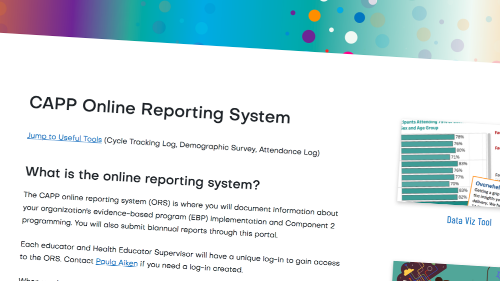CAPP Component 2: Positive Youth Development Programming

Important Reminders
All CAPP projects are now required to implement program activities that promote youth development.
Component 2 (C2) programs should be evidence-informed and developed in coordination with youth.
Youth who participate in C2 positive youth development programming should also participate in a Component 1 evidence-based program (EBP).
Adolescents are faced with many challenges beyond sexual and reproductive health as they transition to adulthood. The CAPP initiative strives to enhance adolescents' social and emotional development and to promote environments that support young people's health and safety. With this focus on broader youth development outcomes, all CAPP agencies are required to provide C2 program activities to:
- Implement educational, relational, vocational, and economic opportunities for youth on multiple health and development topics
- Introduce youth to new situations, ideas, and people
- Challenge and support youth to build skills
- Refer youth to community services to meet identified needs
Engaging Youth in C2 Planning and Leadership
Positive youth development (PYD) theory and practice should guide C2 program development. Youth engagement is a central PYD principle. Through meaningful youth engagement, adults can do a better job of creating the opportunities and supports that young people need to develop in healthy ways.
CAPP projects are required to involve young people in C2 planning. This can be accomplished by involving youth in program selection/design and implementation planning as well as evaluation and quality improvement efforts.
Activities should include ongoing opportunities for youth voice and leadership.

How Much? How Many? It Depends!
Share your program ideas with ACT for Youth for review. Does the program you propose:
- Connect youth from Component 1 to Component 2?
- Include youth voice/leadership?
- Have enough sessions and time to support youth-adult connection?
- Follow PYD principles?
Evidence-Informed Programming
Evidence-Informed vs. Evidence-Based
CAPP projects are required to use evidence-based programs for C1 Sexual Health Education and evidence-informed programs for C2 positive youth development. What's the difference?
- Evidence-based programs have been shown through rigorous, scientific evaluation to lead to certain desired outcomes.
- Evidence-informed programming has a theoretical basis for effectiveness, along with some level of evaluation or preliminary data suggesting that it works.

C2 Tips!
- Wrap C2 sessions around an EBP. For example, offer sessions on healthy relationships and puberty in advance of the sexual health education program, then use add-on sessions after the EBP to spend time on topics participants raised during the program.
- Offer EBP sessions in all health classes one year, then offer C2 programming the following semester or year. For example, offer BPBR in 7th grade and Money Habitudes in economics or social studies classes in 8th grade.
- Recruit youth advisors or peer educators from your EBP groups and develop C2 projects around their interests.
- Consider offering paid internships (discuss budget with your DOH Program Manager).
Potential C2 Programming
Effective youth development programs build on young people's strengths, aim for positive outcomes, and expand opportunities for learning and leadership. Generally, the most effective interventions last nine months or longer, allowing time for developmental relationships to flourish. C2 activities should take place over time to support youth-adult connectedness.
Topics should be related to a healthy transition to adulthood. Possibilities include (but are not limited to):
- Community Resources/Supports
- Relationship Skills and Consent
- Career Preparation
- Financial Literacy
The New York State Department of Health has identified several evidence-informed and promising programs that may be appropriate for Component 2. Selecting a program from this list is optional. Keep in mind that young people from your priority population should be involved in program selection.

Note
Teen Outreach Program (TOP) is a positive youth development program that has been shown to impact rates of sexual activity and teen pregnancy. Effective implementation of TOP requires significant resources. CAPP projects may be able to use this program to fulfill both C1 and C2 requirements. Contact ACT for Youth through the ORS if you are interested in this option.
C2 Evaluation
Using surveys, C2 evaluation will measure the most common outcomes we expect from this programming.
More Information
For more information on how DOH conceptualizes this component, consult the CAPP Request for Applications.








